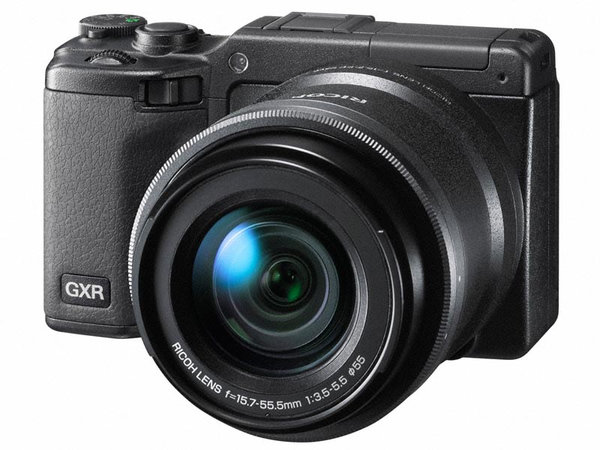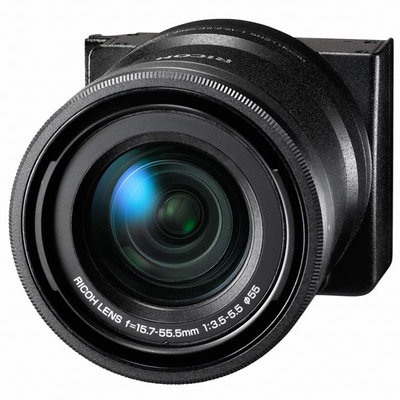odklizec
PK
Tokyo, Japan, February 2, 2012—Ricoh Co., Ltd. (president and CEO: Shiro Kondo) today announced the development and release of RICOH LENS A16 24-85mm F3.5-5.5, the fifth camera unit in the GXR interchangeable unit camera system.
Introduced in December 2009, the GXR is a revolutionary interchangeable unit camera system in which lenses can be changed by mounting camera units that integrate lens, image sensor, and image processing engine into a single unit.
The new RICOH LENS A16 24-85mm F3.5-5.5 brings together a newly developed 24-85 mm wide-angle zoom lens, an APS-C size CMOS sensor, and the proven Smooth Imaging Engine IV to create a unit with high image quality, high power of expression, and high flexibility.
1. Newly developed 24-85 mm wide-angle zoom lens with an APS-C size CMOS sensor with approximately 16.20 million pixels
2. Diverse shooting functions and high operability
3. Highly precise focusing possible
4. The power of expression that is a hallmark of the GXR series
5. New options added
For more details about the unit follow this link:
http://www.ricoh.com/r_dc/gxr/unit6.html
Full resolution sample photos can be seen here:
http://www.ricoh.com/r_dc/gxr/sampleima ... #sample_27
Introduced in December 2009, the GXR is a revolutionary interchangeable unit camera system in which lenses can be changed by mounting camera units that integrate lens, image sensor, and image processing engine into a single unit.
The new RICOH LENS A16 24-85mm F3.5-5.5 brings together a newly developed 24-85 mm wide-angle zoom lens, an APS-C size CMOS sensor, and the proven Smooth Imaging Engine IV to create a unit with high image quality, high power of expression, and high flexibility.
1. Newly developed 24-85 mm wide-angle zoom lens with an APS-C size CMOS sensor with approximately 16.20 million pixels
- ・This newly developed lens features a 9-group, 11-element configuration. The utilization of three double-sided aspherical lenses as well as high-refraction lenses effectively reduces various types of distortion across the entire zoom range. The result is high resolution and imaging power from edge to edge.
・The configuration of nine rounded aperture blades enables both highly precise aperture settings and beautiful bokeh.
・This camera unit features a 23.6 mm×15.7 mm (APS-C size) 16M CMOS sensor. In combination with the image processing engine Smooth Imaging Engine IV, this image sensor makes it possible to shoot high-quality images with smooth tonal gradations as well as low noise and high-resolution.
2. Diverse shooting functions and high operability
- ・Dynamic range compensation reduces overexposure of highlights and underexposure of dark areas. For backlit and high-contrast scenes that cannot be handled with exposure compensation, doing the dynamic range compensation in specific portions of the image makes it possible to shoot the subject at a brightness level close to that seen by the naked eye.
・ISO sensitivity can be set in 1EV or 1/3EV steps.
・With the new ISO bracketing function, the photographer can shoot and record three images with different ISO sensitivities.
・When the new function for maintaining the same shooting settings is set on, by keeping the shutter release button pressed halfway after taking a picture, the photographer can continue to shoot with the same settings (focus, exposure, white balance, etc.).
・The function for recording a JPEG image simultaneously with the RAW image has been expanded so that it is now possible to record only the RAW image. This is suitable for a work flow based on the premise that image finishing is to be done on a PC after shooting. Since a JPEG file is not simultaneously recorded, this option is also useful when the photographer wants to increase the number of images which can be recorded on the memory card.
・It is now possible to turn ON/OFF the white saturation display that shows areas where bright portions will be rendered white and where color shade gradations will be lost.
・The tilt indicator function has been enhanced. In addition to the conventional horizontal indicator, this function can now also detect camera movement direction tilting.
・Copyright information such as the photographer’s name can be entered and written to the image Exif data. The recorded information can be checked on the playback screen detailed information display.
3. Highly precise focusing possible
- ・For the AF area size for spot AF, either normal or pinpoint can be selected.
・A focus-assist function has been included in an effort to raise the accuracy of manual focusing. The photographer can select from two modes and check the focus by strengthening outlines and contrast.
・The shooting screen can be magnified for convenience in focusing. The magnified area can be displayed in the center or across the entire screen. In addition, the image quality for 4x and 8x magnification has been further enhanced. The area to be magnified can be moved using the direction pad.
4. The power of expression that is a hallmark of the GXR series
- ・Picture settings for image quality and color can be customized with nine levels for easy creation of a diverse range of images.
・My Settings enables the settings for a wide range of shooting functions to be recorded in advance and specified in an instant when needed. For the setting storage, now six patterns can be stored in the body’s My Settings Box and six patterns can be stored in the SD card. This expands the world of photo expression by enabling GXR users to exchange their shooting settings.
・B (bulb) and T (time) can now be selected as the shutter speed in manual exposure mode. With “B,” the exposure continues while the shutter release button is pressed, and with “T,” the shutter release button is pressed to start and end the exposure. For both, the exposure is forcibly ended when 180 seconds have elapsed.
・New scene mode options have been added for the easy enjoyment of a wide range of photo expression. The five new options are soft focus, cross process, toy camera, miniaturize, and high contrast B&W. The photographer can create a unique image by just pressing the shutter release button.
・An image flag function has been added to enable the quick display of specific images from among those in the camera. Up to 20 images can be flagged.
・It is possible to shoot 1280 × 720 pixel HD movies.
* Note: When shooting movies of 1280×720 size, the use of an SD/SDHC memory card with an SD speed class of Class 6 or higher is recommended.
5. New options added
- ・A newly designed lens hood (LH-2) especially for this camera unit.

・A lens cap (LC-3) that opens and closes simultaneously with the movement of the lens. It does not need to be removed when shooting.

For more details about the unit follow this link:
http://www.ricoh.com/r_dc/gxr/unit6.html
Full resolution sample photos can be seen here:
http://www.ricoh.com/r_dc/gxr/sampleima ... #sample_27

